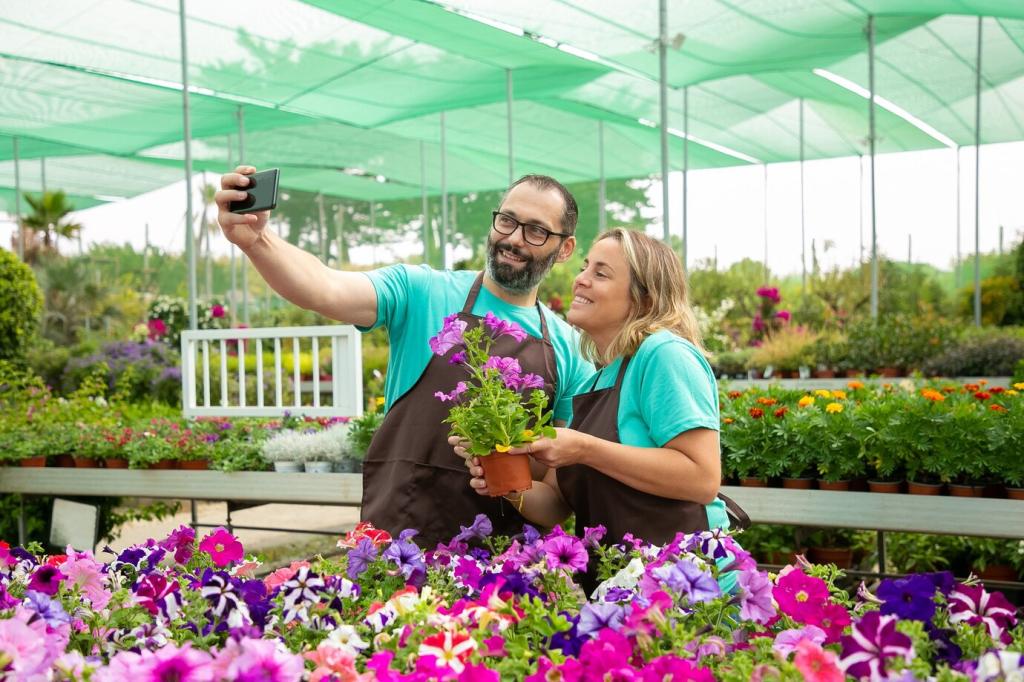Vertical Gardening: Space-Saving Solutions for Urban Areas
Vertical gardening is revolutionizing the way city dwellers think about greenery and food production. As urban spaces become increasingly congested, traditional gardens are a luxury few can afford. Vertical gardening offers an innovative solution, utilizing vertical space on walls, balconies, and fences to cultivate a wide variety of plants. From edible herbs to decorative foliage, vertical gardens breathe life into concrete jungles, transforming underused spaces into lush, productive oases. This guide explores the benefits, techniques, plant choices, and sustainability aspects of vertical gardening for urban environments, helping readers harness the power of greenery no matter how limited their space.

Urban Crowding and the Need for Green Solutions
As more people flock to cities, green spaces are sacrificed for housing and infrastructure. With limited ground area, residents often find themselves without gardens or yards. Vertical gardening answers this challenge, providing a viable option for bringing nature into high-rise apartments and crowded neighborhoods. By growing plants vertically, dwellers can enjoy the therapeutic benefits of greenery, foster a sense of connection to nature, and even contribute to food security, all within a small footprint.
Integrating Nature into Modern Architecture
Modern architecture often emphasizes sleek lines and durable materials, resulting in environments dominated by glass, steel, and concrete. Vertical gardens elegantly bridge the gap between organic beauty and contemporary design, seamlessly integrating lush greenery onto facades, interior walls, and balcony railings. This not only softens the urban landscape but also cools buildings, reduces glare, and insulates interiors, offering both aesthetic and functional enhancements to modern living spaces.
Psychological Benefits for Urban Dwellers
City living, though vibrant, is often fast-paced and stressful. The introduction of vertical gardens into daily environments has been proven to lower stress levels, boost mood, and enhance overall well-being. The presence of living plants, even on a vertical surface, can transform stark surroundings into peaceful retreats, offering city residents much-needed moments of calm and connection with nature. In a world of concrete and commotion, vertical gardening presents a simple yet powerful antidote.
Innovative Vertical Gardening Techniques
Living walls, also known as green walls, are one of the most dramatic forms of vertical gardening. They consist of panels of plants grown in a soil or hydroponic medium, affixed to exterior or interior walls. With proper installation, living walls act as natural air filters, cooling adjacent spaces and insulating buildings. They transform otherwise barren facades into vibrant displays of color and texture, becoming focal points that draw the eye and inspire observers.
Modular planters represent a practical approach to vertical gardening, particularly suited for renters or those with transient lifestyles. These systems feature stackable pots or containers that can be arranged vertically on stands, rails, or walls. Their flexibility allows gardeners to change layouts, move plants as needed, and experiment with different arrangements, ensuring optimal sunlight and easy maintenance. This adaptability makes modular planters a favorite among urban gardeners eager to maximize even the smallest spaces.
For those who enjoy creativity and sustainability, making a DIY vertical garden from upcycled materials is both rewarding and eco-friendly. Common items such as pallets, shoe organizers, or old pipes can be repurposed into striking vertical planters. This approach not only diverts waste from landfills but also enables gardeners to customize their setups, fitting unique spaces and personal tastes. A DIY vertical garden provides satisfaction beyond mere aesthetics, blending resourcefulness with ecological stewardship.

Suitable Plants for Urban Vertical Gardens
01
Growing edibles in vertical gardens is practical and satisfying for city dwellers who wish to supplement their diets with homegrown produce. Leafy greens like lettuce, spinach, and kale thrive in vertical setups, as do herbs such as basil, mint, and parsley. These crops require little root space and can be harvested continually throughout the season. Adding strawberries, cherry tomatoes, and dwarf peppers expands the possibilities and rewards gardeners with a fresh, flavorful harvest right outside their windows.
02
Ornamental plants are essential for vertical gardens designed primarily for aesthetics. Ferns, ivies, and succulents create lush backgrounds with minimal maintenance, while flowering plants like petunias or begonias add vibrant splashes of color. Shade-tolerant species excel in covered balconies or shaded walls, maintaining visual interest year-round. When carefully chosen, ornamental plants provide a dazzling show through every season, enhancing the ambiance and beauty of urban spaces.
03
Urban air is often plagued by pollutants, making air-purifying plants a valuable addition to vertical gardens. Species such as spider plants, pothos, and peace lilies excel at filtering toxins, improving indoor air quality where airflow is limited. Including a variety of air-purifying plants helps reduce levels of formaldehyde, benzene, and other pollutants, creating healthier environments for residents. A vertical garden filled with these species is both attractive and beneficial, making it a smart investment for city homes.
For apartment dwellers, balconies usually represent the only access to outdoor air and sunlight. Vertical gardening techniques capitalize on railing attachments, hanging pockets, or stackable towers to blanket these areas with life. Even with just a few square feet, a balcony can support a vibrant array of herbs, flowering plants, and trailing vines. This transformation not only boosts curb appeal but also offers privacy and tranquility in the heart of the city.
Maximizing Small Spaces with Vertical Gardens
Environmental Benefits of Urban Vertical Gardens
Reducing the Urban Heat Island Effect
Concrete, asphalt, and brick intensify heat in cities, leading to uncomfortable and sometimes dangerous urban heat islands. Vertical gardens cool exterior and interior surfaces by providing shade and through the natural process of evaporation. Buildings with green facades experience lower temperatures and reduced reliance on air conditioning, resulting in energy savings and improved comfort during hot periods. This effect contributes to the overall mitigation of climate extremes in densely populated areas.
Supporting Urban Wildlife and Biodiversity
City landscapes often lack the vegetation needed to support birds, pollinators, and beneficial insects. Vertical gardens help solve this by creating new habitats within the urban matrix. By planting native flowers and shrubs, gardeners attract bees, butterflies, and small birds, promoting biodiversity along building corridors and rooftops. This integration of wildlife into the city fabric not only enriches local ecosystems but also fosters greater environmental awareness among residents.
Improving Urban Air Quality
Air pollution is a significant issue in many cities, posing risks to human health. Vertical gardens act as natural air purifiers, trapping particulate matter and absorbing harmful gases such as carbon dioxide and nitrogen oxides. Strategic placement of these gardens near windows, on roofs, and along busy streets can make measurable improvements in local air quality. This benefit is especially valuable for vulnerable populations, offering a breath of fresh air in densely populated neighborhoods.

Overcoming Limited Sunlight Exposure
Urban buildings often overshadow one another, restricting access to direct sunlight. To counter this, gardeners can choose shade-tolerant species, use reflective materials to bounce light onto plants, or install supplemental grow lights for indoor systems. Regular monitoring of plant health and strategic placement within available light zones is essential to ensure robust growth, especially for sun-loving vegetables and flowers. Adaptation is key to maintaining a thriving vertical garden amid the city’s shadowy spaces.

Efficient Watering and Drainage Strategies
Proper watering is often a challenge in vertical systems, where water tends to drain quickly and unevenly. Incorporating drip irrigation systems or self-watering planters ensures consistent moisture for all plants. Adding moisture-retaining additives to the soil and designing planters with efficient drainage channels can prevent both dryness and waterlogging. These solutions conserve water—an important consideration in cities—and promote healthier, longer-lasting gardens.
Vertical Gardening and Urban Food Security
01
Reclaiming Food Production in City Spaces
As farmland disappears beneath urban development, in-city food production becomes increasingly critical. Vertical gardening reclaims underutilized vertical surfaces for agriculture, allowing residents to participate directly in the cultivation of their own food. Even modest setups provide a regular supply of greens and herbs, reducing dependence on external sources and offering fresher, more nutritious options.
02
Community Vertical Gardens and Urban Agriculture Initiatives
Many cities have embraced community-based vertical gardens, turning walls and fences of schools, community centers, and apartment buildings into productive landscapes. These collective efforts increase food access, teach valuable gardening skills, and strengthen community bonds. Urban agriculture initiatives that include vertical gardening also raise local awareness about sustainability and food systems, inspiring broader change in urban food supply models.
03
Future Trends: Automation and Smart Vertical Farms
As technology advances, vertical gardens are evolving into highly efficient, automated micro-farms. Innovations such as app-controlled irrigation, smart sensors, and integrated lighting systems make it easier than ever for city dwellers to manage their gardens. These trends point toward a future where urban vertical farming becomes commonplace, offering scalable, high-yield food production even in the densest neighborhoods.
